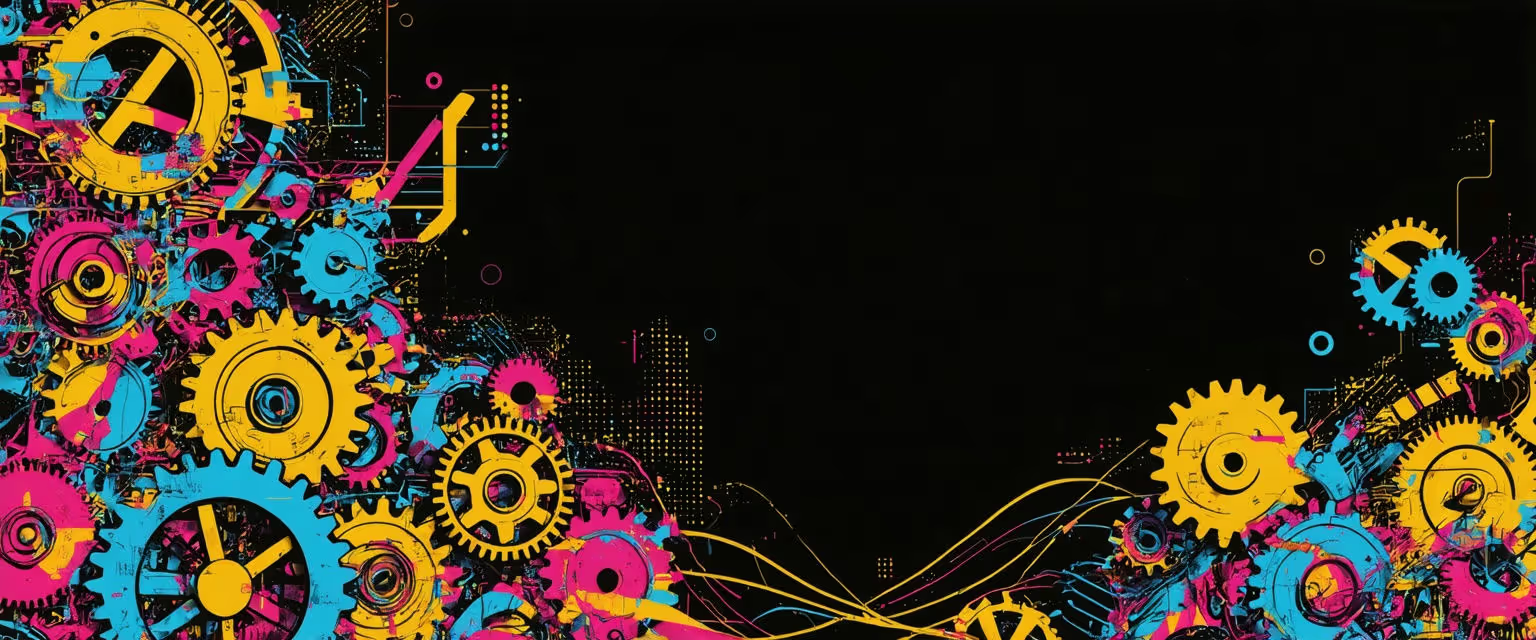Discover how AI-powered solutions can streamline brand guidelines automation in marketing, ensuring consistency, efficiency, and creativity in your campaigns.
Are your brand guidelines scattered across PDFs, emails, and shared drives? This key problem is derailing your brand consistency and costing your team countless hours in manual checks, approval bottlenecks, and inconsistent implementation. Learning how to automate brand guidelines in marketing can help you centralize your guidelines, making it easier to maintain the consistency that customers rely on to recognize and trust your business.
AI-powered brand guidelines can revolutionize your brand management, ensuring consistency and efficiency across all channels. By transforming static brand rules into intelligent, dynamic systems powered by data connectors like those offered by Datagrid, you're not just saving time—you're creating a foundation for brand growth that works even while you sleep.
Understanding Brand Guidelines
Brand guidelines are the clearly defined rules and standards that communicate how your brand should be represented to the world. Think of them as your brand's instruction manual that centralizes its overall look and feel. They're not optional documentation—they're essential tools ensuring everyone promotes your business with the same mission, principles, and personality.
Key Elements of Brand Guidelines
Effective brand guidelines typically include several critical components:
- Company Information: This provides context for all branding decisions by covering your brand's history, mission, values, and vision.
- Imagery: Guidelines on acceptable types of images, icons, and design elements ensure visual consistency across all platforms.
- Logo Design and Use: Clear specifications on how to use your logo, including color variations, file formats, minimum and maximum sizes, spacing requirements, and usage permissions.
- Tone and Grammar: Instructions regarding your brand's voice and grammar rules help maintain a uniform communication style that reflects your brand personality.
- Business Collateral: Templates for business cards and letterheads that ensure consistency in physical branding materials.
- Fonts: Specifications of font styles and text sizes appropriate for both print and digital media.
- Color Palette: Detailed information on your brand colors, including CMYK and RGB codes for accurate reproduction across different media.
The Role of Brand Guidelines in Fostering Consistency
Brand guidelines serve as a comprehensive framework for maintaining brand consistency throughout all marketing efforts. When properly implemented, they offer several key benefits:
- Consistency: They ensure uniformity across various platforms, materials, and touchpoints, promoting a cohesive brand image that customers can recognize and trust.
- Brand Recognition: A well-structured style guide helps in creating a distinctive brand identity, allowing your organization to stand out in the marketplace.
- Efficiency: When everyone has access to clear guidelines, designers, marketers, and other stakeholders can work more efficiently without repeatedly checking or guessing about brand requirements.
- Risk Mitigation: Guidelines protect your brand by ensuring that its identity and assets are utilized correctly and consistently, preventing misrepresentation.
For your brand guidelines to be most effective, they should be concise, easily understandable, and digitally accessible to anyone who might need to represent your brand. When everyone from internal teams to external partners can easily access and understand your guidelines, your brand message remains clear and consistent no matter who's communicating it.
Challenges of Manual Brand Guidelines Maintenance
Managing brand guidelines manually can undermine even the strongest brands. Learning how to automate brand guidelines in marketing helps you overcome these common challenges that make manual brand maintenance so risky.
The Human Error Factor
Even the most careful team members make mistakes when manually reviewing brand assets. A misaligned logo, wrong font, or slightly off-brand color might seem minor, but these errors can seriously hurt your brand.
Time-Consuming Manual Processes
The labor involved in manual brand compliance is staggering. Team members spend countless hours on mundane tasks. After an exhaustive review process, teams face the added challenge of communicating with designers across multiple channels to fix compliance issues. This back-and-forth dramatically slows down campaign launches and creative production.
The Risk of Brand Dilution
When manual processes fail to maintain consistency, your brand faces serious dilution. This shows up as:
- Inconsistent presentation across different marketing channels
- High rejection rates for non-compliant creative
- Gradual loss of brand vibrancy and energy over time
Decentralized Team Challenges
For companies with teams spread across different locations and time zones, maintaining brand integrity becomes exponentially harder. These challenges multiply when facing tight deadlines, especially during peak sales seasons when getting compliant creatives to market quickly affects your bottom line.
The manual approach to brand guidelines maintenance isn't just inefficient—it's becoming unsustainable as marketing channels multiply and content creation accelerates.
Overview of Automation Technologies in Marketing
Automation of brand guidelines in marketing involves leveraging advanced technologies that maintain consistency, improve workflows, and enhance decision-making. These technologies enable brand teams to influence asset development while addressing challenges like high volumes of brand reviews and resistance to compliance.
AI-Powered Brand Management Systems
AI technologies are transforming how brand guidelines are created, managed, and implemented. These systems work best when they're deeply integrated into existing workflows and creative tools—sometimes even as browser plug-ins.
This integration is vital because it enables AI to enhance the creative process rather than feel like an obstacle to creators who resist feeling policed by strict guidelines. By automating design specs, AI tools help streamline the creation and management of brand guidelines, making it easier for creators to comply without feeling constrained.
Next-generation brand management AI solutions focus on interoperability, which speeds up approval processes and provides valuable insights into successful strategies and areas needing improvement. The data gathered from these systems delivers critical brand identity metrics that matter to marketers and brand managers alike.
When implemented thoughtfully, AI can facilitate content checks at scale that actually benefit creators while supporting brand cohesion in the market. This approach helps strike the balance between creative freedom and brand consistency.
Data Automation Platforms
Data automation forms the backbone of modern brand management systems. The most common approach is ETL (Extract, Transform, Load), which involves grabbing data from multiple sources, transforming it, and loading it into a unified system. This process creates a single source of truth that combines data from websites, apps, email campaigns, social media, and more.
When considering data automation, you'll encounter two main types:
- Batch data processing works like a scheduled service—predictable but slow, typically running at set intervals (such as daily)
- Live streaming data functions more like an on-demand service—providing continuous, real-time information that enables immediate responses
For brand management, the choice between these approaches depends on your needs. While batch processing works for regular reports, real-time streaming data is essential when you need to ensure brand consistency across rapidly changing digital touchpoints.
Core Technologies Enabling Brand Automation
Several key technologies work together to make brand guideline automation both possible and effective:
Optical Character Recognition (OCR) converts physical brand assets and documents into digital formats. This technology allows for extracting data from PDFs and other legacy brand materials, enabling their integration into modern systems.
Natural Language Processing (NLP) manages unstructured data found in brand communications, customer feedback, and social media mentions. This helps organizations monitor brand usage and sentiment across channels where strict formatting isn't possible.
Machine Learning (ML) identifies patterns in how brand assets are used, automating repetitive tasks in the brand management process. ML systems can predict and autocomplete brand elements, detect violations, and categorize incoming brand assets automatically.
Agentic AI solutions are transforming how organizations connect disparate brand data sources. These AI agents automate extraction processes that previously required manual effort, reducing errors and streamlining operations. Datagrid's data connectors, powered by Agentic AI, represent how these technologies can simplify the extraction and unification of brand-related information.
Through these advanced integration capabilities, brand data enrichment creates a foundation for consistent implementation across all channels and touchpoints.
Step-by-Step Guide to Automating Brand Guidelines in Marketing
Automating your brand guidelines can transform how your organization maintains brand consistency. By following these practical steps, you'll learn how to automate brand guidelines in marketing, ensuring your brand remains recognizable while reducing the manual workload for your team.
1. Define Your Brand Identity Clearly
Before implementing any automation, you need to have well-defined brand guidelines:
- Document your organization's mission, vision, and values
- Articulate your brand's unique character and voice
- Identify your target market and positioning
- Outline what differentiates your company from competitors
Having these elements clearly defined is crucial as they form the foundation for all automation efforts. Understanding how you wish to be perceived by your audience is essential before you can automate consistent brand experiences.
2. Identify Components to Automate
Next, identify which aspects of your brand guidelines can be automated. This includes rules for logo usage and placement, the application of your color palette with specific CMYK and RGB codes, typography and font styles, guidelines for imagery and photography, tone of voice and messaging templates, as well as designs for business cards and letterheads.
Automating these elements ensures consistency and efficiency across all marketing materials. For each component, establish clear rules that can be translated into automated processes. The more specific your guidelines, the more effectively they can be automated.
3. Select Appropriate Automation Tools
Deploy your automated brand guidelines across all marketing channels by setting up templates with locked brand elements tailored for different media types. Create automated approval workflows to streamline the review and approval process for new content. Establish a centralized hub for easy access to all brand assets, ensuring consistency and efficiency. Implement version control to monitor and track changes over time.
Finally, configure automated alerts to quickly identify and address potential brand violations, maintaining compliance and brand integrity. These intelligent tools allow cross-functional teams to complete data tasks more quickly than manual methods, while maintaining accuracy.
4. Implement Consistent Cross-Channel Automation
Deploy your automated brand guidelines across all marketing channels:
- Set up templates with locked brand elements for different media
- Create automated approval workflows for new content
- Establish centralized access to all brand assets
- Implement version control to track changes
- Configure automated alerts for potential brand violations
Marketing automation tools are particularly effective at maintaining visual and content consistency across channels, which helps boost your brand reputation in a crowded digital landscape.
5. Train Your Team on the New System
Successful implementation of automated brand guidelines requires proper training and clear communication. Conduct workshops to familiarize your team with the new tools and processes. Create simple, easy-to-follow documentation for quick reference and troubleshooting.
Designate brand champions within the team to provide guidance and support to others. Frame automation as a positive step that enhances creativity and efficiency, rather than restricting it. Finally, encourage ongoing feedback from your team to identify areas for improvement and ensure the system evolves to meet their needs.
6. Scale Your Automation Gradually
As your team becomes comfortable with the automated system:
- Expand automation to additional brand elements
- Integrate with other business systems
- Develop more sophisticated rule sets
- Explore AI and machine learning capabilities
- Extend access to external partners when appropriate
By taking a phased approach, you'll allow your organization to adapt to changes gradually while realizing increasing benefits from your automated brand guidelines system. By leveraging AI to automate content briefs, organizations can further streamline the data enrichment process, ensuring that all content aligns with enriched brand data.
How Agentic AI Simplifies Brand Guidelines Automation
Agentic AI is revolutionizing how marketing professionals manage documents and data by employing advanced autonomous systems that streamline processes and enhance decision-making capabilities. Understanding how to automate brand guidelines in marketing includes leveraging such autonomous AI systems, which work independently to optimize your marketing strategies for targeting, engaging, and analyzing your audience more effectively.
Intelligent Audience Targeting
With Agentic AI, you can identify high-potential prospects with unprecedented precision. By analyzing vast datasets, you can:
- Create detailed audience segments based on buyer propensity scores
- Focus your marketing efforts on individuals most likely to convert
- Craft messages that genuinely resonate with specific audience characteristics
The AI continues to learn from interactions, providing increasingly personalized insights that enhance engagement over time.
Automated Data Enrichment
Maintaining current, accurate data is essential for effective marketing. Agentic AI automates data enrichment by:
- Cross-referencing information across multiple sources to uncover key insights
- Automatically updating contact information and adding relevant industry details
- Providing accurate homeowner and household data for personalized outreach
This enrichment process transforms raw datasets into actionable insights, improving data quality while minimizing time spent on manual data entry and corrections. You can then focus on strategic activities that drive marketing innovation and performance.
Multi-Channel Engagement Optimization
Agentic AI optimizes your multi-channel strategies by integrating communication channels and analyzing engagement patterns. This allows you to:
- Adjust outreach timing based on engagement data at scale
- Maintain consistent messaging across all platforms through centralized content management
- Create stronger connections with your audience through aligned communications
AI-Powered Analytics and Reporting
Robust analytics capabilities provide you with strategic advantages for driving marketing strategy:
- Track key engagement metrics across all channels in real-time
- Identify patterns in successful interactions using AI-powered analysis
- Generate detailed reports on campaign performance to guide data-driven strategies
These insights help you understand exactly what components are driving success, allowing you to refine your approaches for improved effectiveness.
Automated Task Execution
By automating routine tasks, Agentic AI frees you to concentrate on high-level strategy:
- Generate and send personalized communications based on prospect behavior
- Automate follow-ups across different platforms that keep prospects engaged without overwhelming them
- Parse interaction logs to provide insights for more targeted marketing efforts
By embracing Agentic AI, you can create more targeted campaigns, improve engagement rates, and make data-driven decisions that optimize your marketing strategies and drive better results.
Simplify Automation of Brand Guidelines with Agentic AI
Don't let data complexity slow down your team. Datagrid's AI-powered platform is designed specifically for marketing professionals who want to:
- Automate tedious data tasks
- Reduce manual processing time
- Gain actionable insights instantly
- Improve team productivity
See how Datagrid can help you increase process efficiency.
Create a free Datagrid account













